May 30, 2025

The article emphasizes the strategic use of behavior momentum in Applied Behavior Analysis (ABA) therapy to significantly enhance learning outcomes and compliance. By initiating therapy sessions with simpler tasks, practitioners can effectively build confidence and engagement among clients. This foundational approach not only facilitates improved skill acquisition but also mitigates challenging behaviors. Consequently, it underscores the effectiveness of leveraging behavior momentum in creating a positive learning environment that fosters success.
In the rapidly evolving field of Applied Behavior Analysis (ABA) therapy, the demand for Board Certified Behavior Analysts (BCBAs) is surging, underscoring the need for innovative strategies that enhance intervention effectiveness. One such strategy is behavioral momentum, a powerful technique that not only fosters positive learning experiences but also significantly improves compliance. By initiating therapy sessions with simpler tasks, practitioners can effectively build confidence and engagement, setting the stage for the introduction of more complex skills.
This method is particularly beneficial for skill acquisition in children with Autism Spectrum Disorder, as it mitigates challenging behaviors and promotes skill generalization. As the landscape of ABA therapy continues to grow, understanding and implementing behavioral momentum strategies is crucial for optimizing therapeutic outcomes.
Are you ready to ensure that your clients achieve their fullest potential? Embrace these techniques and elevate your practice to meet the increasing demands of the field.
Did you know that the demand for Board Certified Behavior Analysts (BCBAs) is projected to increase by 25% by 2026? Hire ABA is here to meet this growing need by serving as a vital resource for BCBAs through a streamlined job matching process that utilizes advanced job fit scoring. This innovative platform connects BCBAs with top-tier job opportunities tailored specifically to their skills, preferences, and desired locations. As a result, employers can easily find qualified professionals who align with their specific needs.
In an industry where finding the right fit is crucial, Hire ABA plays a pivotal role in facilitating a supportive and efficient hiring experience for both job seekers and employers in the field of (ABA) therapy. With personalized guidance and top-notch support throughout the application to negotiation process, Hire ABA ensures that BCBAs land the roles that are perfect for them.
Are you facing challenges in your hiring process? Consider how Hire ABA can address these issues and streamline your recruitment efforts. With our platform, you can confidently navigate the hiring landscape and secure the best talent in the ABA field.
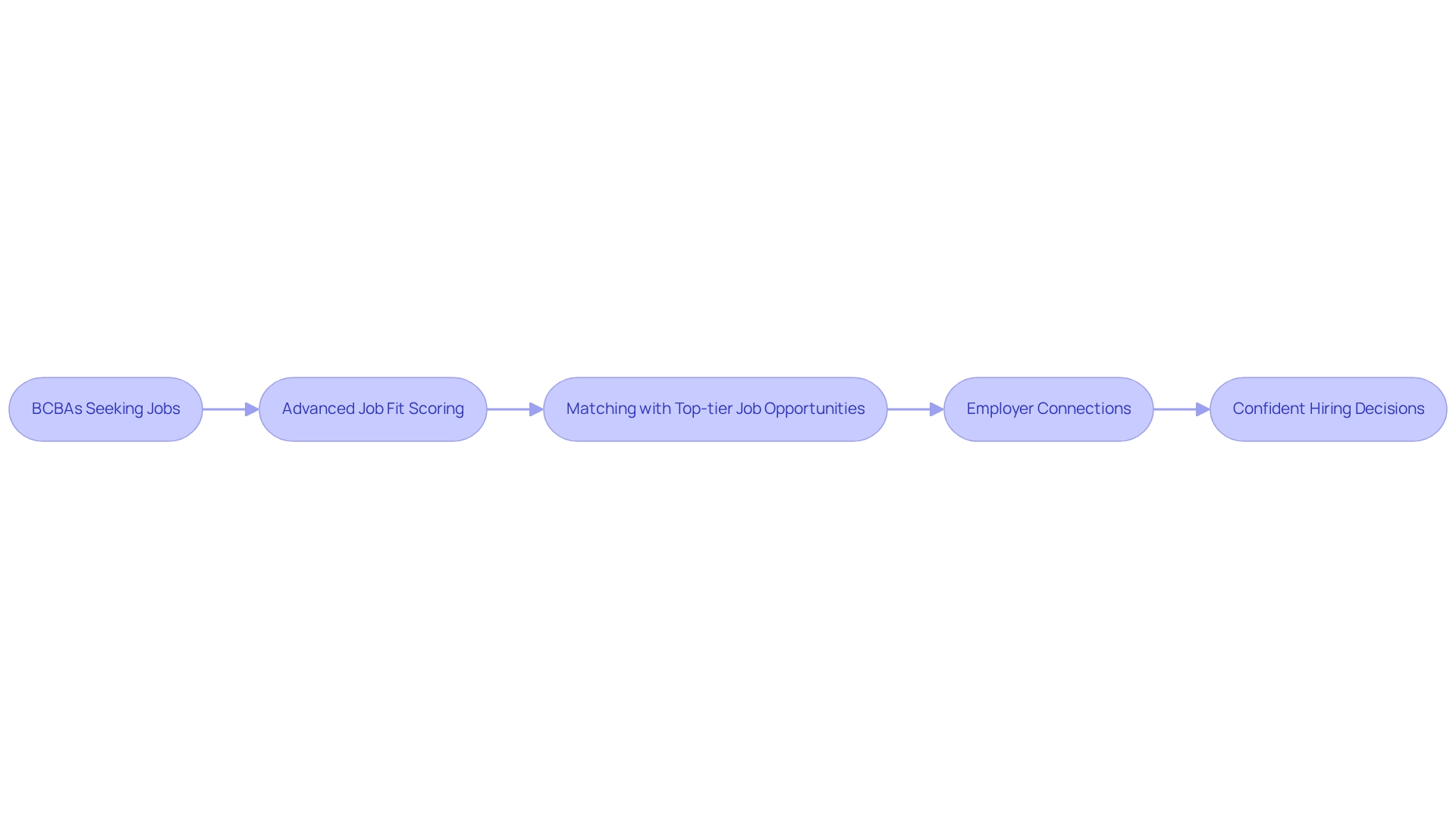
Behavior momentum is a strategic approach in Applied Behavior Analysis (ABA) that starts sessions with simpler tasks, effectively building confidence and engagement before moving on to more complex skills. This method significantly enhances learning outcomes by establishing a positive reinforcement cycle that generates behavior momentum, where early successes boost motivation and compliance. For example, a therapist may start a session by encouraging a young participant to perform straightforward tasks such as clapping or counting, gradually introducing more challenging activities. This fosters a sense of accomplishment and enables the young individual to tackle complex tasks with heightened enthusiasm, enhancing .
Research indicates that this method can lead to enhanced skill acquisition and foster behavior momentum, particularly in individuals with Autism Spectrum Disorder. A study on equivalence class formation revealed that young individuals participating in equivalence-based instruction showed notable advancements in forming intraverbal relations, highlighting the broader applications of behavior momentum in addressing socially relevant issues. As noted by ABA Centers of Florida, "Whether they undergo treatment in our centers with sensory rooms and adapted play areas or prefer the comfort of their homes for sessions, our highly trained and dedicated team ensures that your child receives the personalized attention they require."
By initially focusing on simpler tasks, therapists can effectively leverage behavior momentum to improve learning results, making this method a valuable asset in the ABA toolkit. Furthermore, with the demand for Board Certified Behavior Analysts (BCBAs) projected to rise by 25% by 2026, implementing effective strategies involving behavior momentum is crucial for meeting the needs of this expanding field.
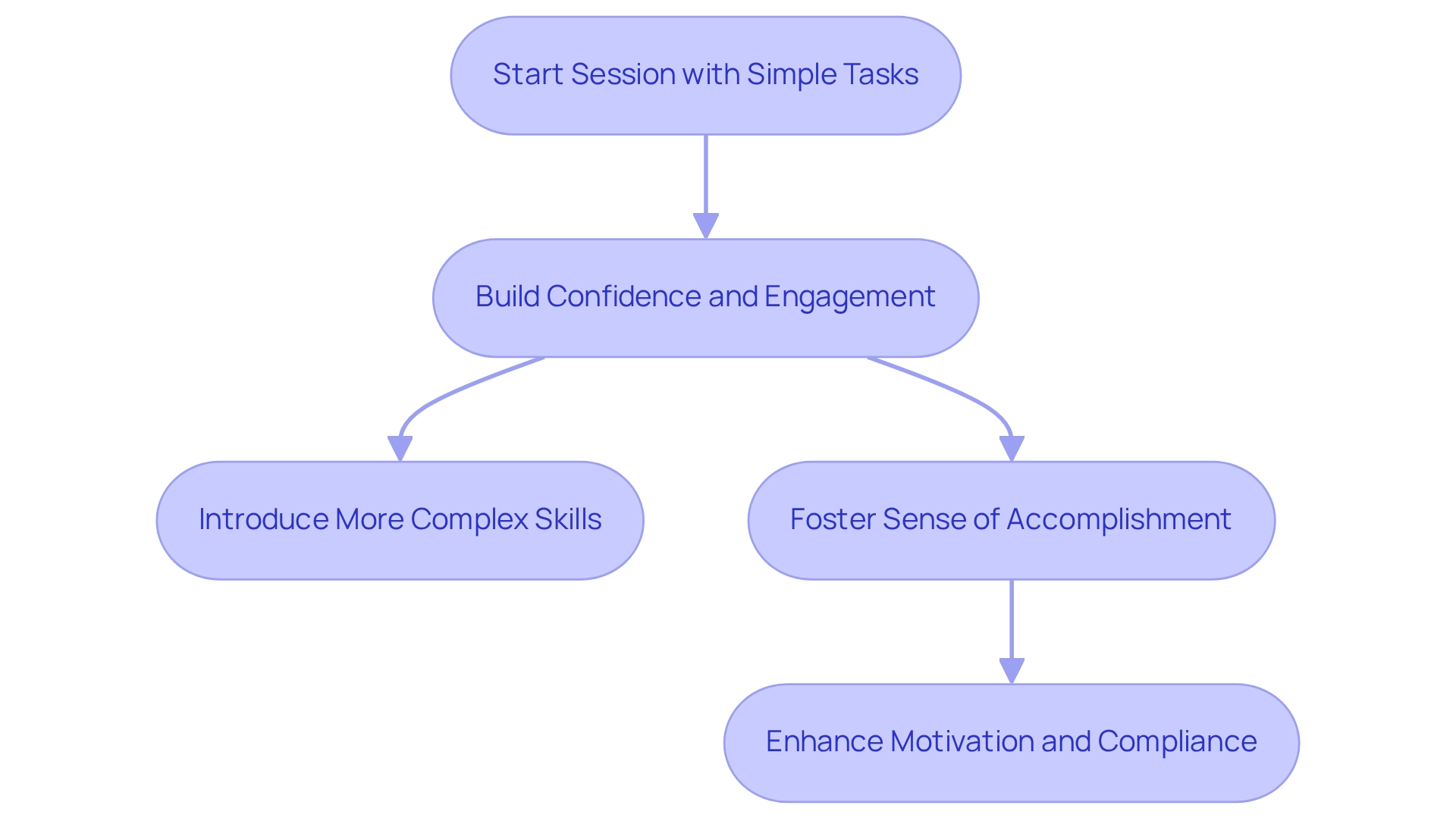
To enhance adherence in ABA therapy, practitioners can effectively utilize behavioral techniques, particularly through high-probability request sequences that foster behavior momentum. This strategy entails presenting a series of simple, easily achievable requests prior to introducing a more challenging, low-probability request.
For example, a therapist may first ask a young person to:
and then transition to a more complex task, such as drawing a picture. This structured approach not only fosters progress but also significantly increases the likelihood of adherence to the more challenging request. As the young individual successfully completes the easier tasks, their confidence and engagement flourish, rendering them more receptive to facing challenges.
Research demonstrates that employing high-probability request sequences can lead to significant improvements in compliance rates, emphasizing the effectiveness of this technique in promoting positive behavioral outcomes and .
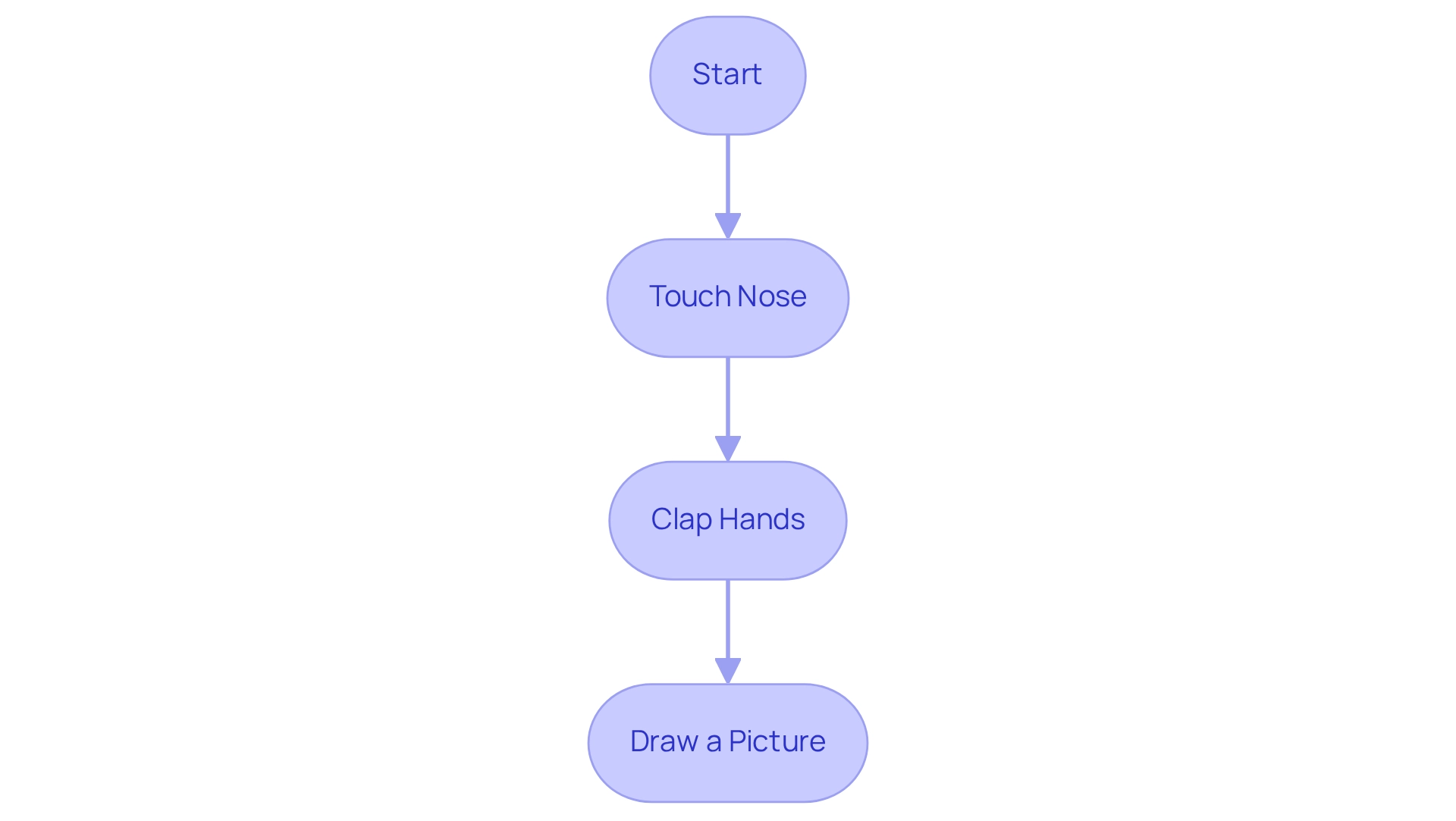
Behavior momentum strategies play a crucial role in alleviating challenging behaviors by creating a structured environment that emphasizes the reinforcement of positive actions. Consider this: when a young person displays challenging behavior, therapists can redirect their focus by engaging them in a series of simple, enjoyable tasks. This approach not only diverts the young one's attention from the undesired behavior but also reinforces positive actions, creating that reduces the likelihood of the challenging behavior resurfacing.
Research consistently shows that the regular application of these strategies fosters a more positive and compliant learning atmosphere. In a notable case study, children who participated in ABA interventions exhibited significant improvements in executive functioning skills, including enhanced planning, organization, and task management. Such outcomes underscore the effectiveness of behavioral persistence in promoting emotional mastery and diminishing challenging behaviors in individuals with Autism Spectrum Disorder (ASD).
By implementing these strategies, therapists can cultivate organized settings that encourage positive behavior momentum, ultimately enhancing the overall effectiveness of ABA.
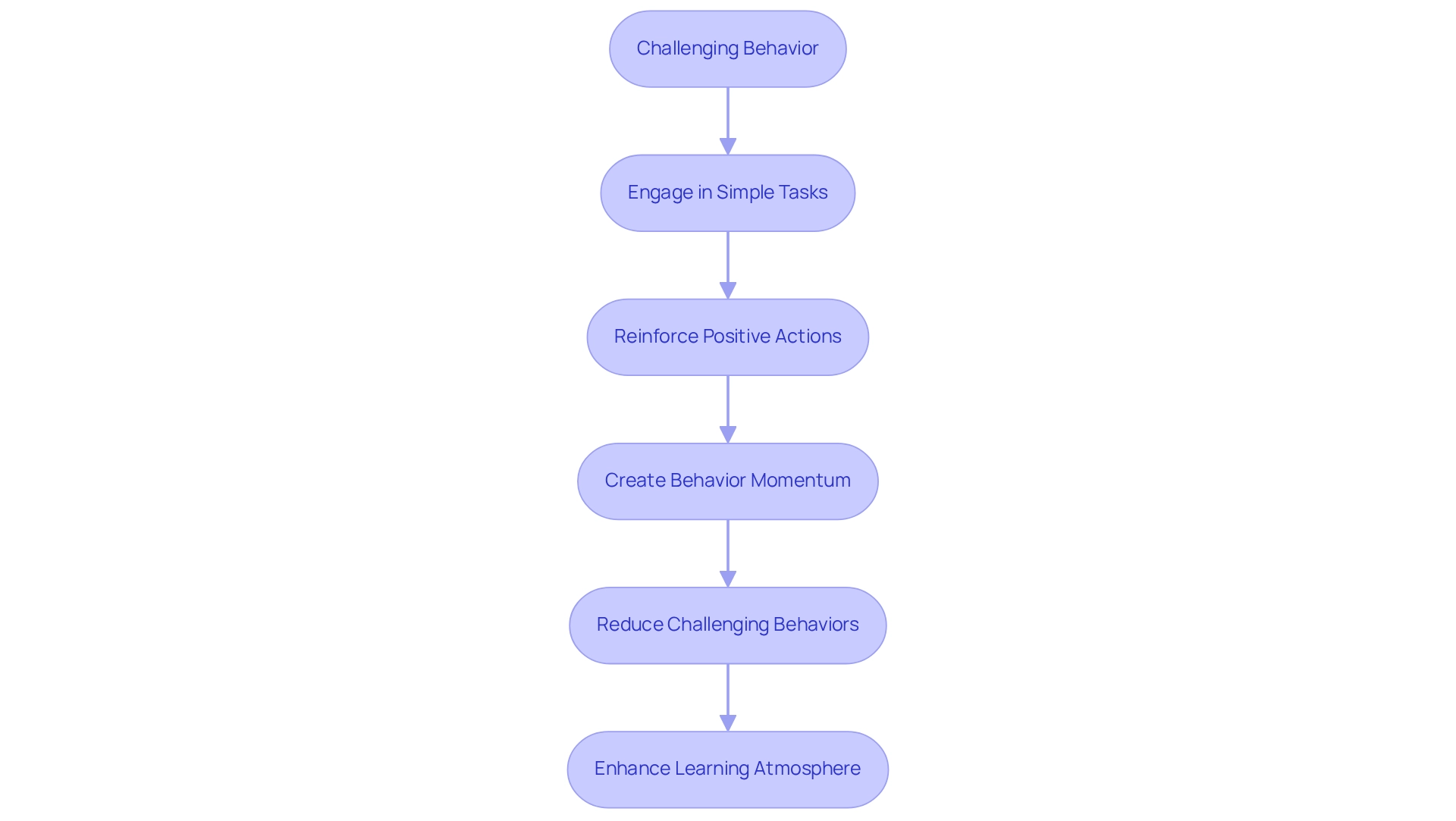
Effectively utilizing reinforcement is crucial for sustaining behavior momentum in ABA therapy. Positive reinforcement strategies—such as verbal praise, tokens, or access to preferred activities—greatly increase the likelihood of desired behaviors being repeated.
For instance, when a young one successfully completes a series of tasks, prompt praise or a small reward can be offered by the therapist. This approach not only reinforces the behavior but also boosts the child's engagement and motivation throughout the session.
The consistent application of reinforcement solidifies the connection between effort and reward, creating a supportive learning environment that fosters behavior momentum and encourages individuals to engage in positive behaviors consistently. Techniques such as praise, tangible rewards, and preferred activities are commonly employed to maintain behavior momentum, demonstrating the profound impact of immediate reinforcement on engagement levels.
As highlighted in various case studies, these strategies are tailored to individual preferences, ensuring that the reinforcement is both effective and meaningful.
BCBAs should actively seek out new opportunities in to leverage their skills and advance their careers.
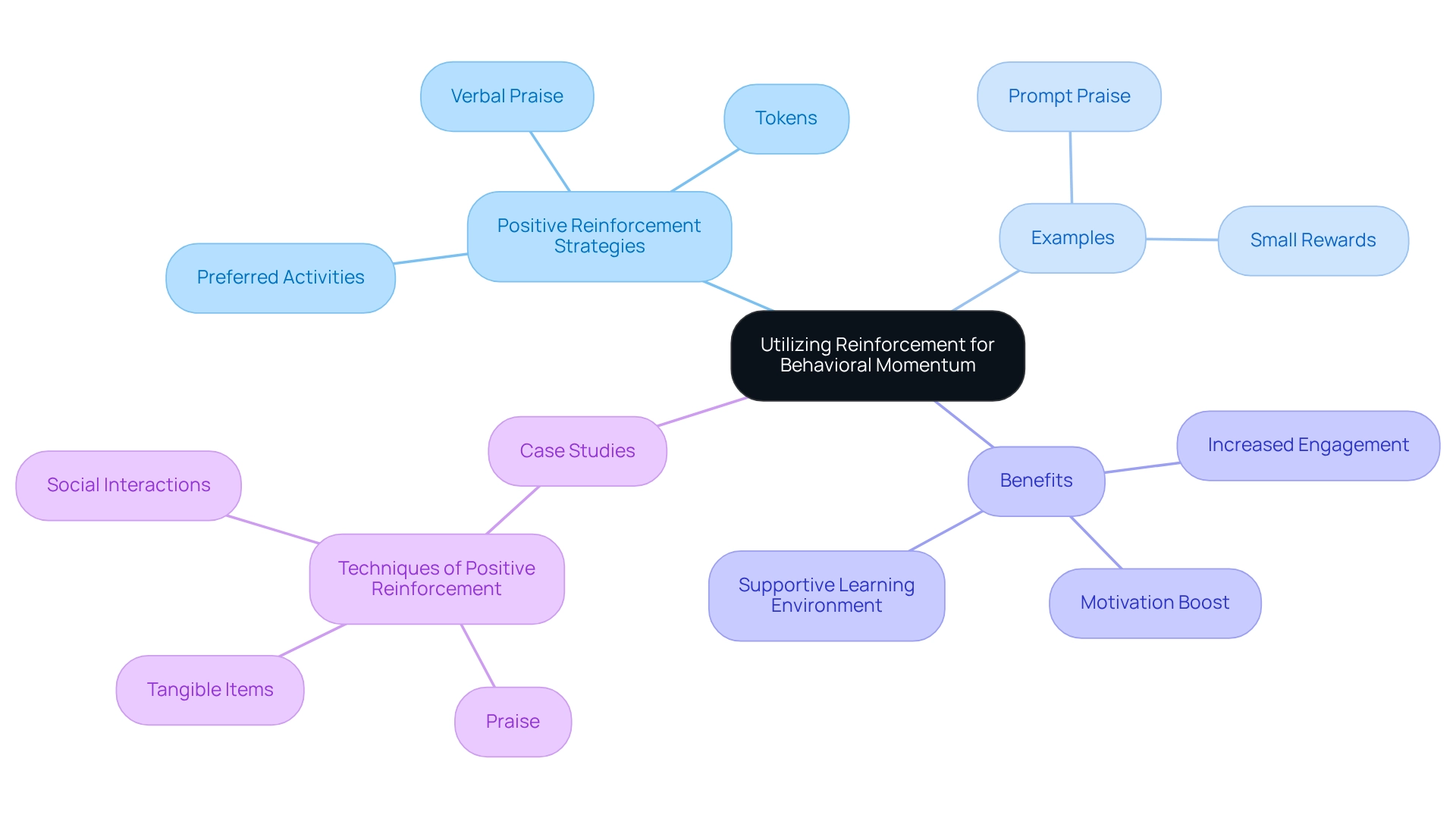
The demand for (BCBAs) is projected to increase by 25% by 2026, underscoring the urgent need for effective recruitment strategies. A notable case study illustrates this need, involving a 6-year-old individual with autism who struggled with task compliance. The therapist employed a behavioral strategy that leveraged behavior momentum, initiating the session with simple tasks like sorting colored blocks, which the child found enjoyable and could easily accomplish. Following several successful completions, the therapist introduced a more challenging task: completing a puzzle. The child, buoyed by earlier successes, complied with the request. This case exemplifies how effectively utilizing behavior momentum can enhance compliance and engagement in therapy sessions.
Moreover, children were required to repeat the model after corrective feedback and were given opportunities to tact independently, further supporting the effectiveness of this strategy. As ABA treatment continues to expand, new opportunities are emerging, often accompanied by increased salaries and adaptable working conditions. Expert insights, such as those from Laura Kelly, highlight the practical implications of these strategies in educational environments, emphasizing their significance in improving the quality of support for individuals with autism. Additionally, addressing sensory sensitivities in children can significantly enhance their overall quality of life, making customized strategies that utilize behavior momentum essential in ABA therapy.
Are you facing challenges in hiring qualified BCBAs? Consider how platforms like Hire ABA can effectively address your recruitment needs and ensure that your organization is well-equipped to provide the best support for individuals with autism.
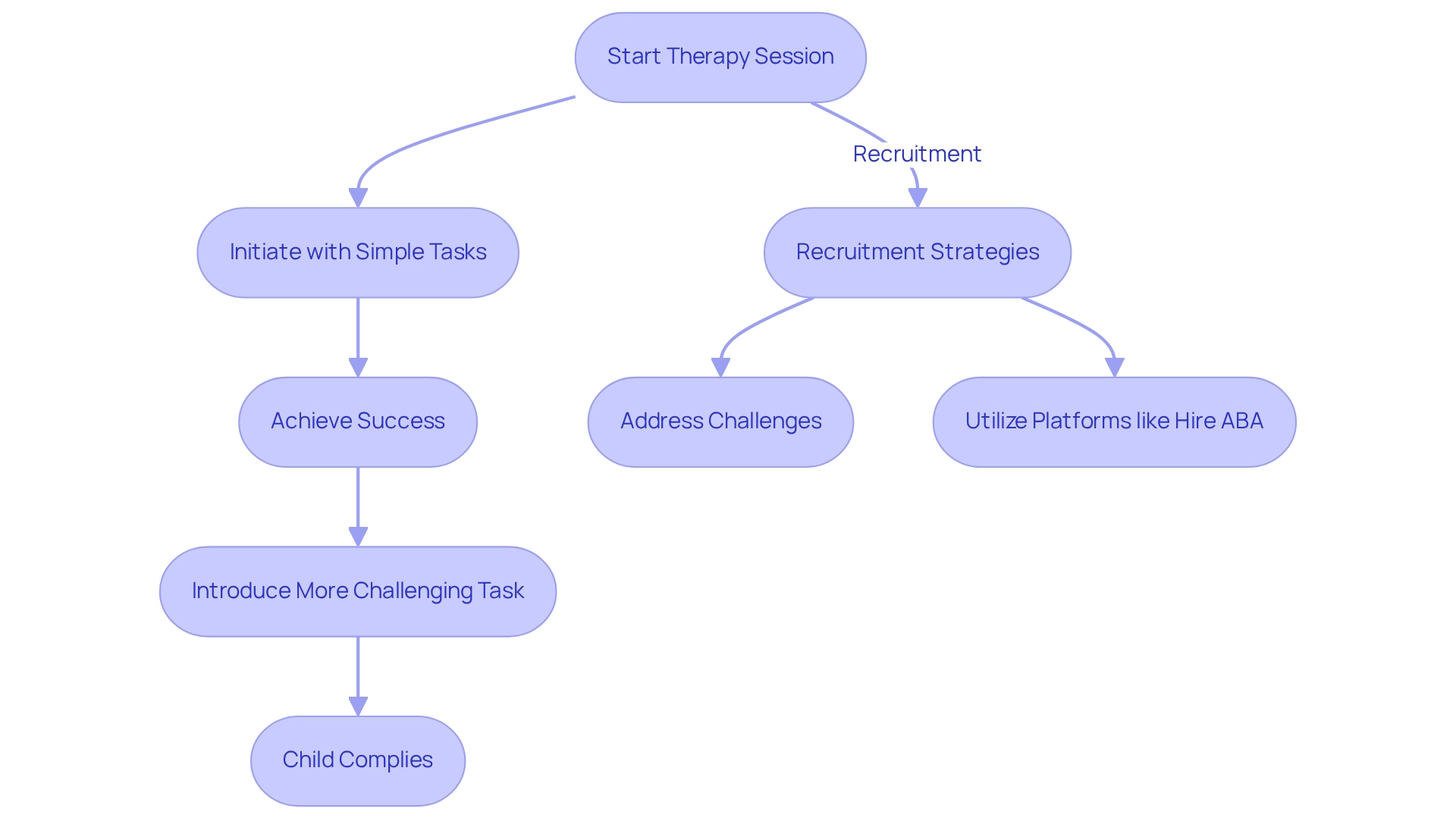
Behavioral persistence theory is fundamentally anchored in the principles of operant conditioning, which asserts that behaviors reinforced consistently are more likely to endure. This theory posits that behaviors characterized by behavior momentum, due to a history of reinforcement, demonstrate increased resistance to change, making them more likely to occur even when faced with obstacles. This phenomenon reflects physical dynamics, where an object in motion tends to stay in motion.
By understanding this theoretical framework, practitioners can develop interventions that effectively utilize behavior momentum, thereby enhancing learning and compliance among clients. For instance, research indicates that children exhibit greater persistence in behaviors that have behavior momentum due to positive reinforcement, highlighting the importance of consistent reinforcement strategies in ABA therapy.
Moreover, case studies, like the one with pigeons conditioned under an intermittent reinforcement schedule, demonstrate how non-contingent reinforcement can greatly enhance operant responding, further supporting the principles of behavior momentum in practice. Understanding these dynamics equips behavior analysts to implement that foster enduring behavioral change and promote behavior momentum.
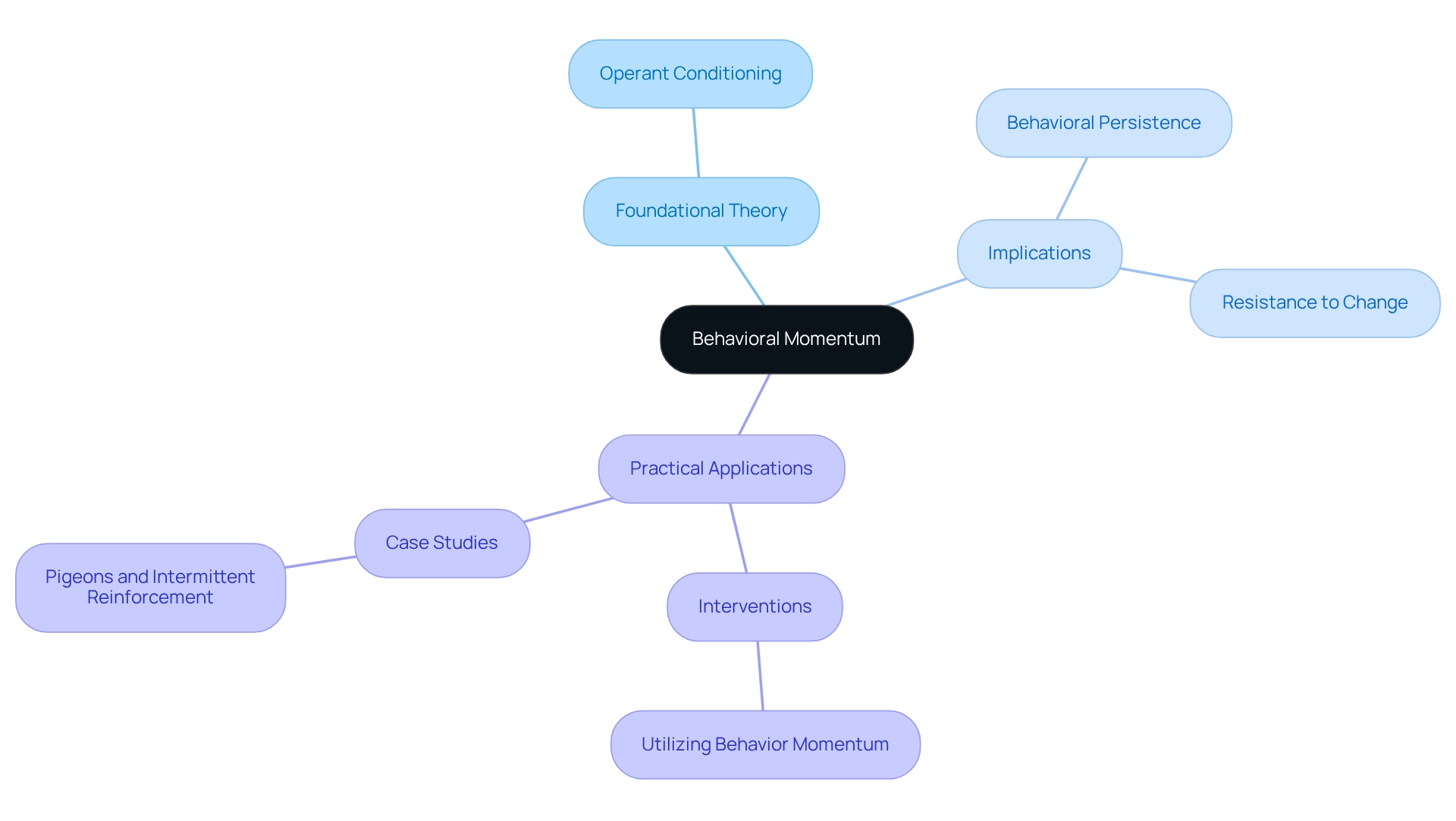
Behavior momentum plays a crucial role in promoting skill generalization by fostering a consistent and supportive learning environment. Starting treatment with familiar tasks and progressively introducing variations allows therapists to effectively guide clients in applying learned skills across diverse contexts. For instance, when a young person learns to ask for assistance in a structured environment, the therapist can gradually transfer this ability to less organized settings, such as at home or during social interactions like playdates. This gradual exposure not only strengthens the skill but also motivates the child to apply their learning to new contexts, ultimately improving their independence and adaptability.
Research indicates that children may receive up to 40 hours of ABA intervention per week, underscoring the significance of maximizing the effectiveness of each session. Successful instances of skill generalization through behavior momentum demonstrate that when therapists maintain consistent learning environments, clients are more inclined to apply skills acquired in sessions to real-life situations. Expert opinions affirm that this approach not only aids in skill transfer but also significantly enhances overall outcomes in ABA therapy, establishing it as a vital strategy for practitioners. Furthermore, the U.S. Department of Health & Human Services recognizes ABA as a 'best practice' for treating children and youth with ASD, reinforcing the credibility of these methods. Additionally, research has shown that ABA treatment is more effective than alternative methods, such as nursery, portage, and DIR, highlighting the importance of behavioral progress in achieving successful outcomes. The endorsement of ABA by governmental bodies further supports , guiding policy and practice in the field.
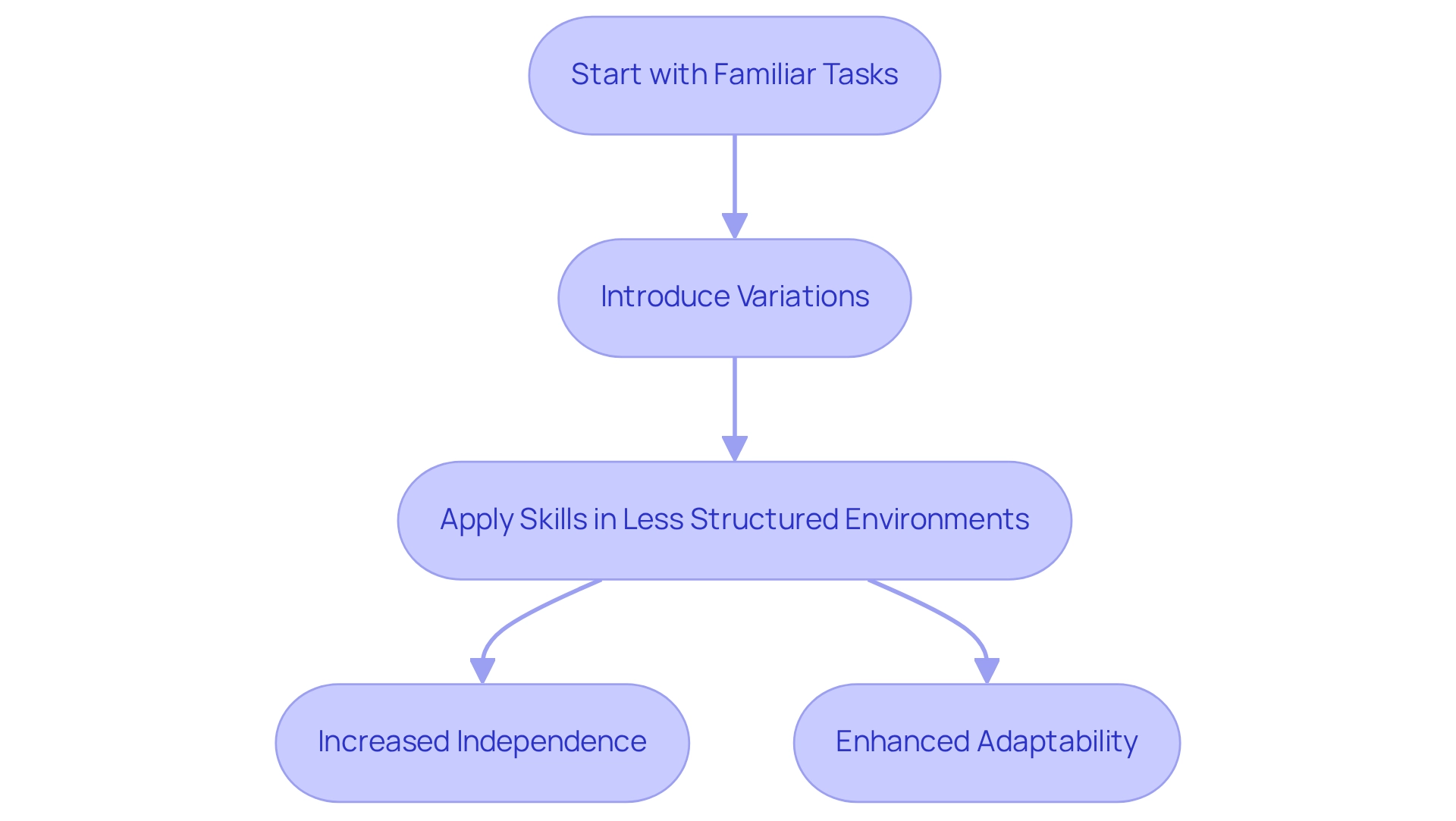
Applying behavior momentum strategies in ABA practices presents several challenges that practitioners must adeptly navigate. A primary obstacle is the necessity for consistency in reinforcement and task presentation. Research indicates that was 98.5%, underscoring the critical nature of consistently applying behavior momentum-building techniques. Erratic implementation can lead to client misunderstanding and disconnection, thereby weakening the efficacy of the treatment. Notably, client engagement levels significantly decline when reinforcement is inconsistent, highlighting the importance of a structured approach to behavior momentum, as individual differences among clients further complicate the application of these strategies. Variations in motivation and skill acquisition rates can influence how clients respond to techniques that build behavior momentum. To mitigate these challenges, practitioners should regularly evaluate their methods and adapt strategies to align with each client's unique needs. This involves ensuring that reinforcement is prompt and appropriate, which is vital for sustaining engagement and encouraging favorable outcomes.
Expert opinions emphasize the importance of preserving consistency in ABA treatment. As behavior analysts note, behavior momentum fosters a consistent approach that creates a stable learning environment, allowing clients to thrive. Iso-Ahola and Dotson describe this as an altered and felt state of mind in which a performer senses things going unstoppably their way. By directly addressing these challenges and utilizing customized strategies—such as motivational interviewing methods to enhance client self-efficacy—therapists can significantly improve the effectiveness of behavioral progress in their practice. Furthermore, comprehending these challenges can inform hiring and training practices for BCBAs, ensuring they are equipped to implement these strategies effectively.

Behavior momentum is a vital strategy in ABA therapy that enhances learning outcomes, increases compliance, and reduces challenging behaviors. Starting with easier tasks and utilizing effective reinforcement techniques allows practitioners to build confidence and engagement in their clients.
Research indicates that youngsters must complete exercises involving behavior momentum, consisting of high probability tacts followed by low probability tacts delivered within 1-minute timings, significantly improving skill acquisition rates. A study titled '' revealed that while young individuals retained learned skills well, challenges in generalizing these behaviors across different contexts persisted.
This underscores the importance of creating interventions that encourage skill generalization, especially for individuals with Autism Spectrum Disorder (ASD). Expert opinions suggest that future research should focus on tailoring fluency procedures to individual needs, as Maria noted, potentially enhancing outcomes.
Furthermore, the importance of fluency outcomes for progression through educational objectives for children with developmental disabilities cannot be overstated. Ultimately, utilizing behavior momentum can lead to significant improvements in skill acquisition and generalization, making it a powerful tool for ABA therapists.
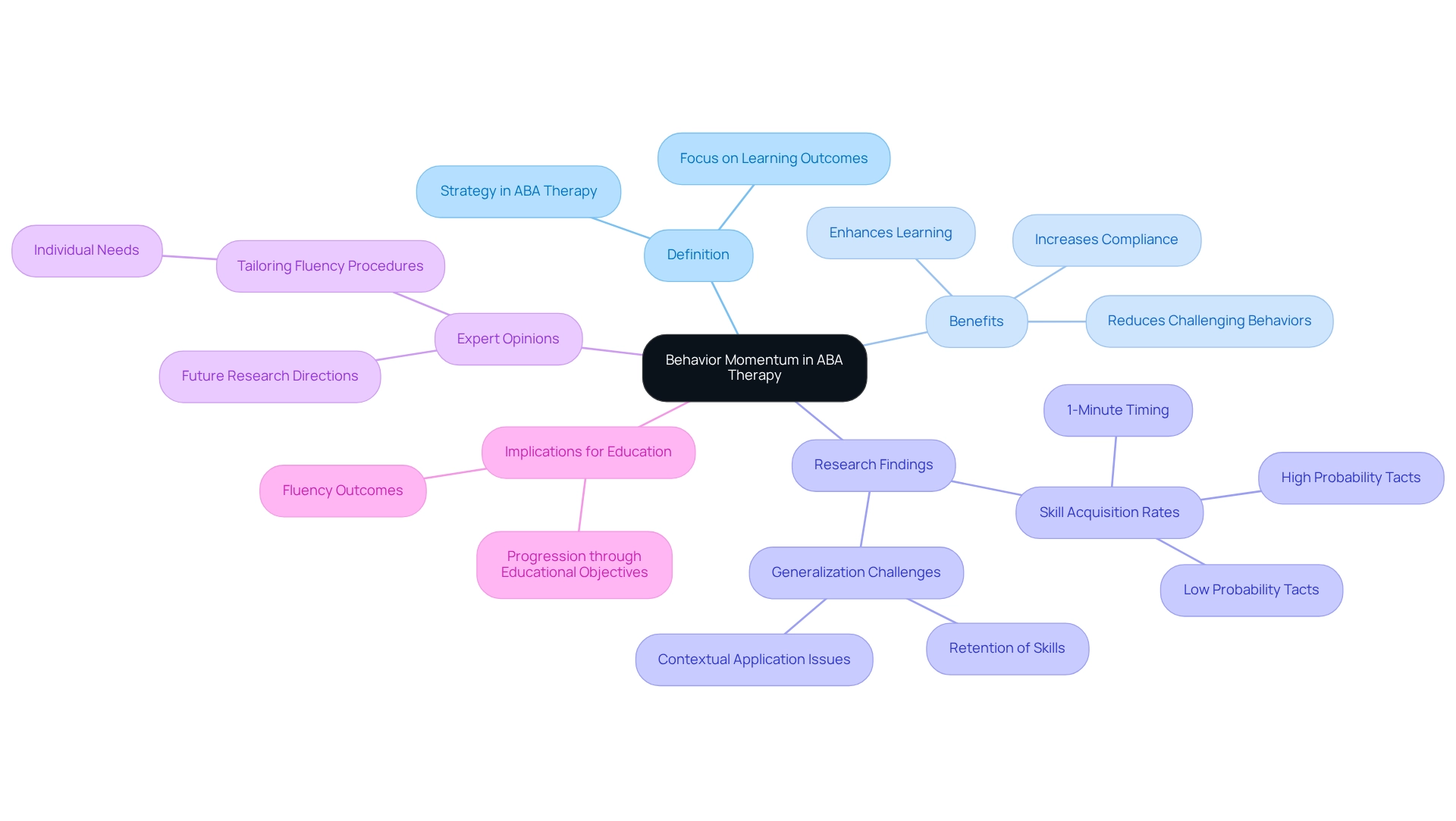
Behavioral momentum represents a transformative approach within Applied Behavior Analysis (ABA) therapy, providing a structured framework that enhances learning outcomes, boosts compliance, and mitigates challenging behaviors. By commencing therapy sessions with simpler tasks, practitioners can initiate a positive reinforcement cycle that fosters confidence and engagement, ultimately paving the way for the acquisition of more complex skills. This method not only aids children with Autism Spectrum Disorder in overcoming obstacles but also promotes the generalization of learned skills across various contexts, contributing significantly to their overall development.
As the demand for Board Certified Behavior Analysts (BCBAs) continues to surge, grasping the principles of behavioral momentum becomes increasingly essential. The effective implementation of this strategy, coupled with consistent reinforcement techniques, can yield substantial improvements in client engagement and success rates. Moreover, addressing potential challenges that may arise during its application ensures practitioners are well-equipped to tailor interventions to meet individual client needs.
In conclusion, embracing behavioral momentum not only enhances the effectiveness of ABA therapy but also aligns with the evolving landscape of the field. As BCBAs leverage these strategies, they can craft impactful learning experiences that empower clients to thrive and realize their fullest potential.
What is the projected demand for Board Certified Behavior Analysts (BCBAs) by 2026?
The demand for Board Certified Behavior Analysts (BCBAs) is projected to increase by 25% by 2026.
How does Hire ABA assist BCBAs in finding job opportunities?
Hire ABA provides a streamlined job matching process that utilizes advanced job fit scoring to connect BCBAs with top-tier job opportunities tailored to their skills, preferences, and desired locations.
What role does Hire ABA play in the hiring process for BCBAs?
Hire ABA facilitates a supportive and efficient hiring experience for both job seekers and employers in the field of Applied Behavior Analysis (ABA) therapy, ensuring that BCBAs find roles that are perfect for them.
What support does Hire ABA offer throughout the application process?
Hire ABA offers personalized guidance and top-notch support throughout the application to negotiation process.
How can employers benefit from using Hire ABA?
Employers can easily find qualified professionals who align with their specific needs, streamlining their recruitment efforts.
What is behavior momentum in Applied Behavior Analysis (ABA)?
Behavior momentum is a strategic approach that starts sessions with simpler tasks to build confidence and engagement before moving on to more complex skills, enhancing learning outcomes.
How does behavior momentum improve learning results?
By establishing a positive reinforcement cycle where early successes boost motivation and compliance, behavior momentum helps individuals tackle complex tasks with heightened enthusiasm.
What evidence supports the effectiveness of behavior momentum?
Research indicates that behavior momentum can enhance skill acquisition, particularly in individuals with Autism Spectrum Disorder, and improve compliance rates through high-probability request sequences.
What is a high-probability request sequence in ABA therapy?
A high-probability request sequence involves presenting a series of simple, easily achievable requests before introducing a more challenging, low-probability request to foster progress and increase adherence.
How does starting with simple tasks affect a child's engagement in therapy?
Starting with simple tasks builds the child's confidence and engagement, making them more receptive to facing challenges and improving their overall learning experience.
Our expert recruitment strategies and AI-driven sourcing ensure that you receive top-notch candidates quickly, without compromising on quality. Whether you’re looking for BCBAs, Clinical Directors, or RBTs, we’ve got you covered.